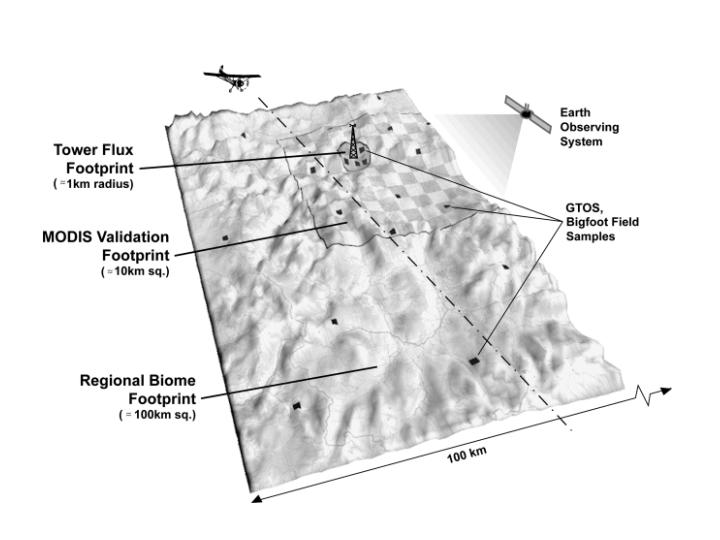MODIS Flux Tower Comparison
Project Summary
Validation of MODIS GPP with AmeriFlux Eddy Covariance Towers
Using MODIS and eddy-flux estimates of Gross Primary Production (GPP) data from several climate regimes, we are analyzing the accuracy of the MODIS GPP (MOD17A2) algorithm. The standard MODIS Output uses coarse 1º X 1.25º resolution daily minimum air temperature and humidity from the NASA Data Assimilation Office (DAO) as a control on the photosynthetic assimilation of atmospheric CO2. We evaluate the sensitivity of MODIS outputs to input meteorology by using both DAO and site-based daily weather information to calculate GPP from the standard MODIS GPP Algorithm as part of an on-going validation effort for the MOD17 Algorithm (Figure 1). The plan for validation combines satellite, model and tower outputs as in Figure 1. The model, Biome-BGC (NTSG - Ecosystem Modeling), is used to scale point-scale tower measurements to coarse-resolution satellite data, allowing for validation of satellite estimates of GPP and NPP. The MOD17A2 (EOS) algorithm is validated by using tower meteorology as inputs to the algorithm and comparing the results to tower estimates. The MODIS GPP logic is based on the concept of Radiation Use Efficiency, developed by Monteith (1972, 1977). It requires a number of inputs from earlier in the MODIS product stream, including land cover classification, fraction of photosynthetically active radiation (fPAR), and leaf area index (LAI), as well as daily surface weather from the DAO including air temperature, vapor pressure deficit, and incident shortwave radiation. Additional parameters are found in the Biome Properties Lookup Table (BPLUT), which is divided into ten major biome types. Outputs from the MOD17 Algorithm include both 8-day total GPP (MOD17A2) and annual GPP/NPP (MOD17A3). An intermediate product, 8-day PSNnet is also created by the algorithm. More information on the MOD17 Algorithm and its application can be found in the MOD17 User Guide and on the MODIS Project website.
One of the keys to the success of the MOD17 validation effort is our continued collaboration with member sites of FLUXNET, a global network of tower sites which use eddy covariance techniques to measure the exchange of CO2 and water vapor between vegetation and the atmosphere. Current validation efforts at NTSG are focusing on towers within the AmeriFlux network, although validation efforts are being conducted globally. In addition, a typical tower measures micrometeorological variables including temperature, precipitation, wind speed/direction and solar radiation. Flux towers have a relatively small footprint (radius 1 km) in comparison with MODIS (pixel = 1 km2), making it necessary to use multiple measurement strategies to ensure complete validation. These strategies include both large-scale sampling (e.g., the BigFoot Project) and aircraft measurements of CO2 concentration.
Results
Validation began with a frequency analysis of GPP by biome type. These results indicate that the MODIS GPP Algorithm is capturing the general trends of the biomes, with shrubs and grasslands being the least productive (<1 gC m-2 d-1) and forests being the most productive (ENF ~ 8 gC m-2 d-1; DBF ~ 9.5 gC m-2 d-1). Next, 5X5 km grids were established surrounding all of the active AmeriFlux sites for 2001. The MODIS GPP outputs were compared directly with tower estimates of GPP. Current research indicates if DAO meteorology and tower meteorology are similar, MODIS GPP is comparable to tower GPP. But, if the coarse-resolution DAO data is not representative of the site, MODIS GPP can differ greatly from tower GPP. Current site data comparisons are weighted heavily towards forest biomes.
Image(s)

Selected Publications
Heinsch, F. A., Zhao M., Running S. W., Kimball J. S., Nemani R. R., Davis K. J., Bolstad P. V., Cook B. D., Desai A. R., Ricciuto D. M., et al. 2006. Evaluation of remote sensing based terrestrial productivity from MODIS using regional tower eddy flux network observations IEEE Transactions on Geoscience and Remote Sensing, Volume 44, Number 7, p.1908-1925.
